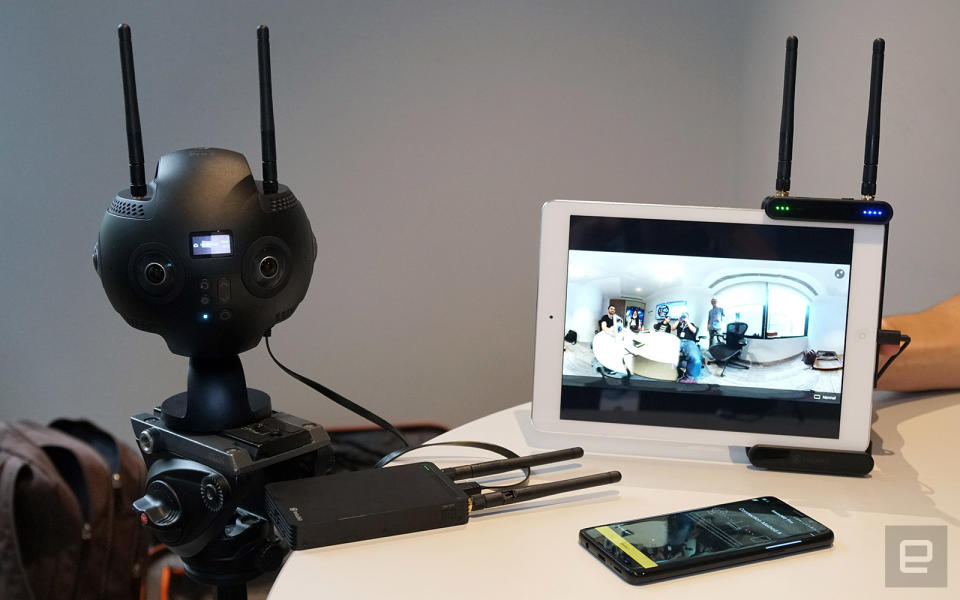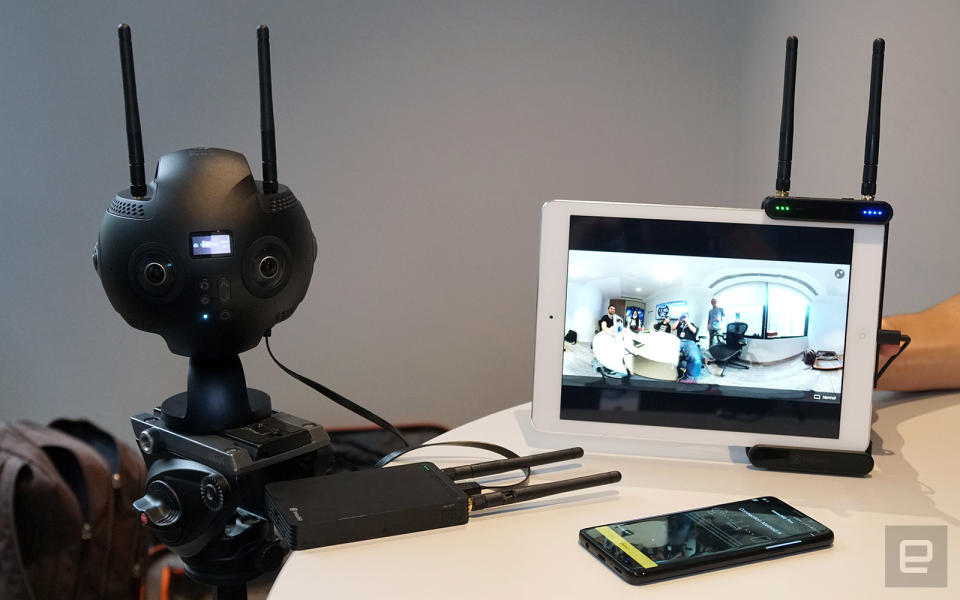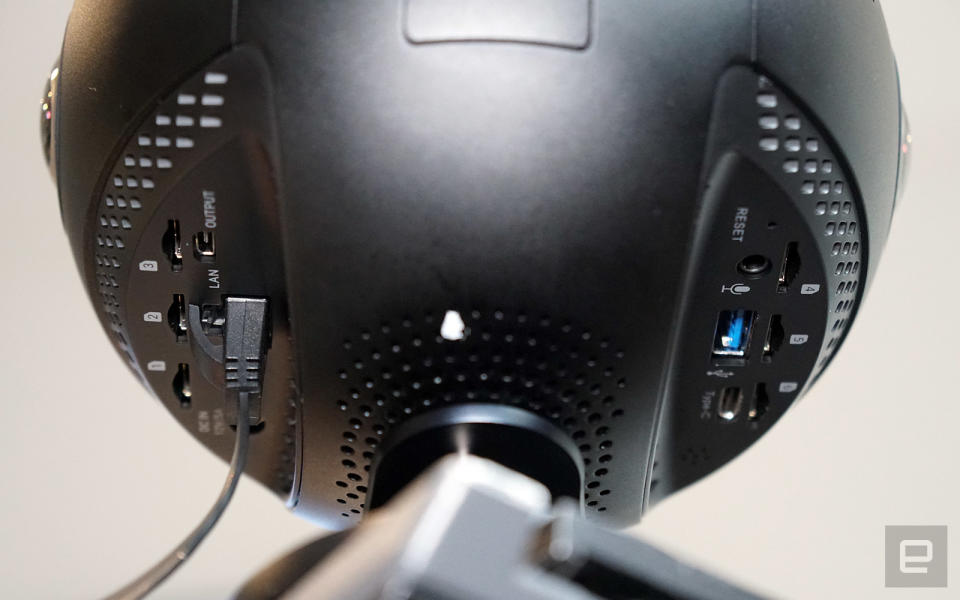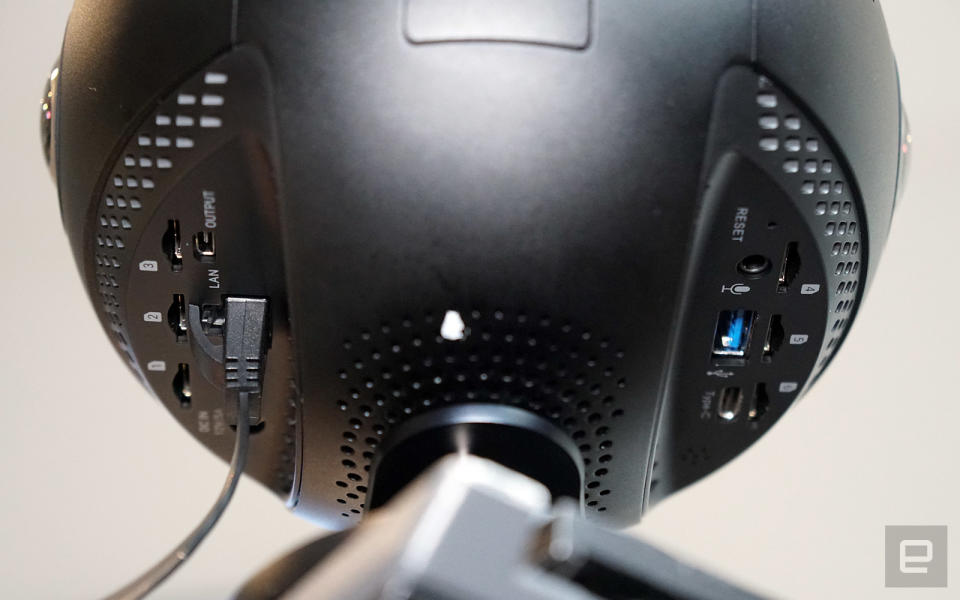Insta360 Pro 2 captures 8K VR video with stabilization
The camera's new video transmission kit also promises to be more reliable than WiFi.
Back in December, Insta360 managed to prolong the life of its professional VR camera, the aptly-named Insta360 Pro, with a significant firmware upgrade. But of course, since there is only so much that software can do, the company is now bringing us the Insta360 Pro 2 to offer a bigger performance bump, while also aiming to simplify one's VR production workflow.
Most notably, this 3.42-pound camera can capture 360 video at up to 8K 3D at 30 fps, and thanks to its new 9-axis gyroscope, it's backed by the company's impressive FlowState stabilization technology, thus offering more creative freedom to users. Another major addition to the kit is the dedicated "Farsight" 5.18GHz video transmission system, which is plugged into the camera via the LAN port, has a 300m range and is said to be a more reliable alternative to the old WiFi for live monitoring on a mobile device; hence the higher price tag -- $5,000 instead of $3,499.
The familiar-looking Pro 2 still consists of six 200-degree f/2.4 lenses, but with each lens powered by a new sensor for maximum bit rate of 120 Mbps, plus direct access to one microSD card each for post-processing stitching (all six slots can be found under the belly); this is why this camera is able to capture up to 8K 2D at 60 fps, 8K 3D at 30 fps or even 8K 2D HDR at 30fps.
The old full-size SD card can still be found under the removable battery (which lasts for up to 60 minutes), and in this mode, it's used for storing gyroscopic metadata (for FlowState stabilization) plus a low-res clone of the clips from all six lenses. These proxy files are designed for use with Insta360's Adobe Premiere Pro plug-in, which lets you make quicker edits using those smaller files, and then it applies those edits to their full-res counterparts for the final output. I'm sure that this time-saving feature will be much appreciated by the 360 video editors out there.
For those who prefer the old quick and dirty way, you can still toggle real-time stitching and have the stitched footage stored on the full-size SD card, but you'll only get up to 4K 3D at 30 fps -- still a slight bump from the old 24 fps limit. It's worth pointing out that the original clips per lens are still saved to the microSD cards in this mode, so should something go horribly wrong with the auto stitching, you can always just grab the original files and stitch manually. Likewise for 360 live-streaming which supports up to 4K 2D at 30 fps (4K or 8K 2D clips of the same frame rate are stored simultaneously per lens) or 4K 3D at 30 fps (4K 3D or 6K 3D clips are stored).
Not much has changed for stills: The Pro 2 benefits from the same-old 12K multi-photo composite mode using post-processing stitching, and it supports up to 7,680 x 7,680 in 3D with real-time stitching.
Given the seemingly impressive FlowState stabilization here, the Pro 2 will likely see more mobile usage. The company found that those who carry its original Pro around tend to use their own audio recording equipment, so to make their lives easier, it's added an extra pair of 3.5mm mic-in jack plus a USB port near the top of the Pro 2. That way the users are no longer limited to sticking their own recording devices to the bottom side of the 360 camera. But for those who aren't too fussed about audio, they can simply use the Pro 2's four built-in mics instead.
Also found near the top of the Pro 2 are two new antennas: One for GPS and the other for WiFi. The latter offers the same 30 fps frame rate for live monitoring while within a five-meter range, which still serves as a handy backup should your Farsight kit run out of battery (it should be good for three hours) or is out of service.

Another bottleneck that Insta360 is trying to solve is the playback ability for the general consumer. While it's nice to have 8K VR content on hand, the best playback equipment that most people have is the smartphone, which isn't powerful enough to render 8K video. Insta360's answer to this is its "CrystalView" technology: This one-click conversion essentially slices up an VR video into little segments, and then Insta360's mobile video player can apply fixed foveated rendering, so that only parts of the VR video are rendered at full quality at any instance, thus vastly reducing the system resources required. This, of course, also allows Insta360 users to quickly preview their content -- even if in 8K -- on smartphones.
Given the $5,000 price tag, the Insta360 Pro 2 clearly isn't meant for everyone, but based on the list of specs and features, it should solve many pain points faced by the professionals -- especially on the mobility side, which will hopefully lead to more interesting VR content in the very near future. For those who want to give this camera a spin, you can already place an order today and expect shipment within 15 to 20 business days.











